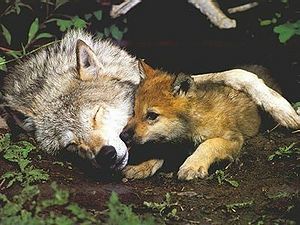Protest and Flyer for wolves @ "The Grey" 2 3 12
Protest and Flyer for wolves @ "The Grey" 2 3 12
[improve]

- Date: February 3rd, 2012
- Time: 6:45- 7:30 PM
- Location: Regal Fox Tower 10, 846 SW Park Avenue, Portland, OR
- Jump to this event's wiki page, edit it, discuss it or return to the events page.
Purpose
The new film "The Grey" portrays grey wolves, currently on the endangered species list, as blood-thirsty killers and could lead many to have a severely skewed perception of these intelligent, family oriented creatures. Sadly, this movie topped the box office last weekend, grossing over 20 million dollars. Join us as we pass out informative flyers to moviegoers. This protest will continue, every Friday, until this movie is no longer showing.
Other details
“The notion that wolves attack humans is ridiculous,” says Wendy Keefover, carnivore-protection director for WildEarth Guardians, one of several groups that has called for a boycott of the film, claiming it’s “inciting terror” of wolves in the same way that Jaws did of sharks.
Most people don’t know anything about wolves. This movie will tap into their primal fears and create mass hysteria,”
Only two fatal wolf attacks have been documented in the history of North America, yet "The Grey" depicts wolves as eviscerating (hu)man-eaters. The result will be disastrous for wolf-conservation efforts.
Predators like wolves are vital to the health of ecosystems. The impacts of wolves on prey populations and surrounding natural areas is one of the most popular topics in ecology and conservation biology today. The reintroduction of wolves in the Northern Rockies and other regions around the world, has allowed for extensive study of how wolves impact ecosystem health and functionality. In areas where wolves are absent ungulates like elk, deer, and moose tend to increase dramatically leading to declines in native plant species as well as the general degradation of forests and ecosystems. Studies have documented that when wolves are absent, elk and moose overgraze cottonwoods, willows, and aspens in key riparian (water) habitats. In areas where wolves have returned, ungulate populations are reduced by predation, and they are more vigilant and active, because of fear of predation, which allows stream side shrubs and trees to grow. This “landscape of fear” affects a prey animal’s behavior in food acquisition and modifies plant communities. With the return of riparian habitat, beavers and many bird species are supported. When woody species grow, expand in canopy cover, and increase in their spatial distribution, other benefits accrue, such as improved floodplain functioning, channel stabilization, increased shading, improved food web support, and an overall increase in biodiversity.
Without the presence of top-down pressures exerted by apex predators such as wolves, natural areas become simplified, less diverse, and unstable.
To add insult to injury, the cast actually ate wolf meat.
"Liam Neeson and others cast members of the film ate wolf meat while filming in Alaska. According to Contactmusic, Director Joe Carnahan wanted the actors to really put themselves in the shoes of the characters, stuck in the frozen wild. So, he had frozen wolf meat flown in, because that’s what people stuck in the snow and ice and fighting for their survival do, right?
Carnahan said of the meat, none of the cast or crew killed the wolf, saying “Some guy had him in his basement. I don’t know if it was a trap line wolf but it was a wolf that had been up to a misdeed of some sort. They were preying on cattle. We had asked if there was one we could eat and sure enough this guy had one in his freezer for six months which probably didn’t help the taste!”
The wolf was “up to a misdeed?” More accurately, one might say the wolf was up to preying on animals that he or she would eat to survive, unlike the stars of “The Grey.”
From- http://www.ecorazzi.com/2012/01/17/liam-neeson-and-the-grey-cast-ate-wolf-meat/
[RSVP on Facebook http://www.facebook.com/events/162359430541968/ more information]